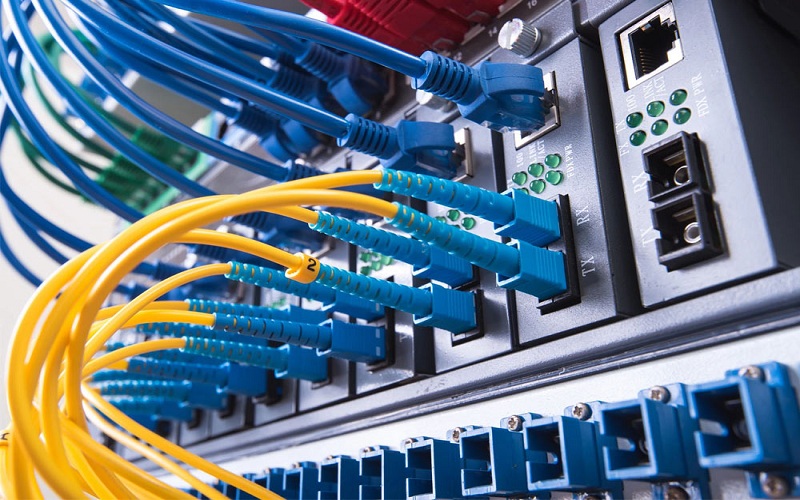Selecting the right IT-structured cabling system is crucial for any modern business. The cabling infrastructure forms the backbone of the IT network, impacting productivity, security, and future growth. Here are some tips on choosing the best cabling system for your needs.
Consider your speed and bandwidth requirements.
The cabling system must support both your current and projected requirements. For most businesses today, Cat 6 or Cat 6A cabling is recommended. These standards provide 10 Gbps and 100 Gbps transmission speeds, respectively. You’ll also want to ensure the cable runs in your building are less than 295 feet. This adherence to standards helps maintain signal integrity across the entire network. When planning your system, think carefully about the bandwidth needs of applications like VoIP, video streaming, storage networks, and more. Get the speed and bandwidth right from the start.
Choose the Right Cabling and Connectors
When it comes to the actual cables and connectors themselves, you’ll want high-quality, standards-compliant components. For copper cabling, CAT 6 and CAT 6A cables must meet specific ANSI/TIA standards for performance. Be sure to verify that any cabling you purchase has been properly tested and certified.
The connectors on both ends are also important for maintaining signal quality across cable runs. Shielded RJ-45 connectors help protect against electromagnetic interference. Meanwhile, jacks and patch panels should be from leading manufacturers, meeting Category 6 or 6A standards. Pay attention to component quality; it impacts the reliability of the entire infrastructure.
Design for Scalability and Future Growth
Another key consideration when choosing a structured cabling system is scalability. Your business will inevitably require additional bandwidth, connections, and capabilities in the future. The it structured cabling system needs to be designed to grow with you.
That means planning for extra capacity, leaving spare ports available on patch panels. It also means using modular components that allow for easy system expansion. With a scalable design, you can simply add new ports, patch panels, and horizontal cabling as needed. The main cable runs through conduits, and vertical risers won’t require changes.
Consider Both Copper and Fiber Optic Cabling
Today, most structured cabling systems utilize a combination of copper and fiber-optic cabling. Copper provides cost-effective connections for networks spanning less than 100 meters. Fiber optics are better suited for longer runs and extremely high-bandwidth applications.
Evaluate where each type of cabling makes the most sense. Fiber might link core switches across different floors, while copper handles connections from floor switches to individual rooms. Mixing copper and fiber gives you the best of both technologies in one infrastructure.
Accommodate power over Ethernet if required.
Some business environments also benefit from Power over Ethernet (PoE), which allows network data and power to be delivered over a single Ethernet cable. PoE can provide electricity to things like VoIP phones, wireless access points, IP cameras, and IoT devices.
When designing a cabling system, consider if you’ll require PoE now or in the future. If so, the infrastructure must support higher wattages across longer cable runs. This may influence choices like cable gauges, conduit sizes, and switch port densities. Build in support for PoE from the start.
Ensure proper installation and testing.
Once you’ve selected the right cabling and components for your business, proper installation and testing are crucial. Structured cabling projects are complex, involving wall plates, patch panels, cable runs, and more. Consider having certified professionals handle both the physical installation and network testing.
Installation should adhere to all industry standards. Cables need proper termination with consistent techniques. Proper grounding and isolation safeguard against electrical interference. Meticulous labeling aids future troubleshooting and additions. Thorough testing across all cable runs verifies everything is connected correctly before deployment. Structured cabling is a mission-critical system, so leave the work to qualified teams.
Plan your security camera infrastructure.
For many businesses, a key part of the structured cabling system will support CCTV security cameras. When planning this aspect, think about camera positioning, resolution, frame rates, storage, and wired vs. wireless access. Map out the cabling paths required back to centralized equipment rooms and patch panels.
Modern IP cameras have high bandwidth and power requirements. Choose Poe-enabled switches that can supply enough wattage for multiple devices. Run Cat 6 or better cabling for optimal video resolution, with surge protectors to safeguard the system. Also, consider a redundant path back to the network core when designing camera cabling.
Consider both wired and wireless access.
The structured cabling system will likely need to support both wired network drops and wireless access points. Make sure the design facilitates flexible connections for desktop computers, VoIP phones, printers, wireless nodes, and other devices.
Map out where wired drops make sense, such as conference rooms, offices, and counter areas. Evaluate choices like under-floor raceways for modular cubicle deployments. For wireless, ensure cabling runs can reach PoE switches located near wireless access points. Blend wired and wireless for comprehensive and convenient access across the facility.
Choose a Partner Experienced with Structured Cabling
Given the complexities involved, it’s wise to choose an experienced partner for your structured cabling project. Look for vendors and contractors familiar with ANSI/TIA standards and best practices. Evaluate their experience across corporate, healthcare, education, and other environments similar to yours.
During the planning process, they should offer design assistance and recommendations tailored to your specific needs. This includes mapping out cabling runs, placement of network closets, fiber/copper choices, and more. They should also have qualified teams to handle professional installations and perform verification testing when they are complete. This expertise is invaluable for long-term success.
Conclusion
Selecting the optimal structured cabling system and the best cctv installation is an important decision for any growing business. You want an infrastructure designed to meet both current needs and future demands. Following the tips outlined in this article will help you make the right choices. Focus on speed, scalability, proper installation, and working with experienced partners. Your investment in the right cabling will pay dividends for years to come through enhanced performance, security, and agility. With smart planning, your business can have an IT environment positioned for long-term success.




